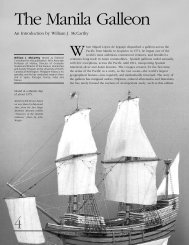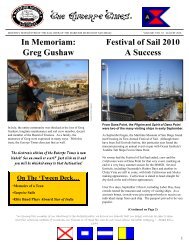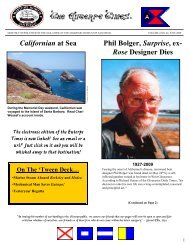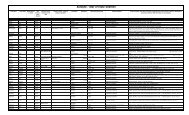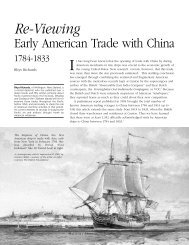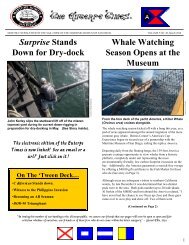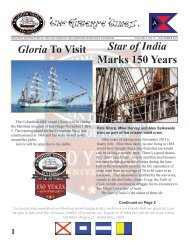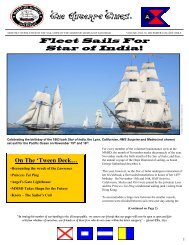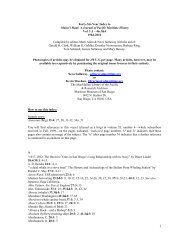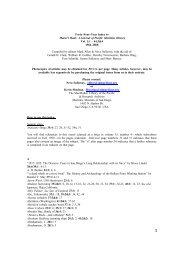Juan RodrÃguez Cabrillo And The Building Of The San Salvador
Juan RodrÃguez Cabrillo And The Building Of The San Salvador
Juan RodrÃguez Cabrillo And The Building Of The San Salvador
You also want an ePaper? Increase the reach of your titles
YUMPU automatically turns print PDFs into web optimized ePapers that Google loves.
21 Alvaro de Paz, testimony given 15 December 1563, AGI, Justicia 290,<br />
fol. 81v, 20 May 1559; AGI, Patronato 62, fol. 3-3v; letter from the<br />
Indians to the King, 15 March 1547, AGI, Guatemala, 52.<br />
22 Testimony given in August 1541, AGI, Justicia 280, fol. 25v. In addition<br />
to their religious names, Spanish ships were commonly called by the<br />
names of their owners or masters. In Alvarado’s fleet, the Diosdado<br />
was owned by Antonio Diosdado and the Figueroa by <strong>San</strong>tos de<br />
Figueroa, etc.<br />
23 Diaz del Castillo, Historia verdadera, chap. 149, p. 330.<br />
24 Kelsey, <strong>Juan</strong> Rodriguez <strong>Cabrillo</strong>, 69-70; Testimony of Luis González, 28<br />
April 1560. AGI, Justicia 290, fol. 63v.<br />
25 <strong>The</strong> fleet is described by Gonzalo Fernández de Oviedo in his<br />
Historia general y natural de las Indias, isles y Tierra Firme del Mar<br />
Oceano (Madrid: Imprenta de la Real<br />
Academia de la Historia, 1853), 4:20,<br />
23, and by Alvarado in his letter to<br />
the King, 28 March 1541, Colección<br />
de documentos, ser. 2, vol. 2, pp.<br />
1-3. Alvaro de Paz, mayordomo for<br />
Alvarado, also confirmed the number.<br />
See his testimony of 20 May 1559, AGI,<br />
Patronato 62, fol. 3v.<br />
26 Testimony of Luis González, 20 April<br />
1560, AGI, Justicia 290, fol. 63v.<br />
27 See Bjorn Landstrom, <strong>The</strong> Ship: An<br />
Illustrated History (Garden City, N.Y.:<br />
Doubleday & Co., 1961), pp. 112-113.<br />
28 Testimony of Luis González, 20 April<br />
1560, AGI, Justicia 290, fol. 63v.;<br />
statement by <strong>Juan</strong> Rodríguez <strong>Cabrillo</strong>,<br />
ca. August 1541, AGI Justicia 280,<br />
fol. 25-26.<br />
29 A ducado in 1500 was worth about<br />
$4.00 according to a study made in<br />
1941 by J. Villasana Haggard, author<br />
of the Handbook for Translators<br />
of Spanish Historical Documents<br />
(Austin: University of Texas, 1941). It<br />
is extremely difficult to place a value<br />
on Spanish gold coins of previous<br />
centuries because of the variables<br />
depending on new discoveries made<br />
from time to time.<br />
30 Testimony of Ginovés (Gines) de Mafra, 2 September 1540, AGI,<br />
Justicia 280, fol. 25-30; Testimony of <strong>Juan</strong> Rodríguez <strong>Cabrillo</strong>, August<br />
1540, AGI, Justicia 280, fol. 25v.-16.<br />
31 Kelsey, <strong>Juan</strong> Rodríguez <strong>Cabrillo</strong>, 83-113<br />
32 Arthur S. Aiton, Antonio de Mendoza: First Viceroy of New Spain<br />
(Durham, NC: Duke University Press), 146, note 19.<br />
33 Iris H.W. Engstrand, “Seekers of the Northern Mystery,” in Ramon<br />
Gutierrez and Richard Orsi, eds., Contested Eden (Berkeley and Los<br />
Angeles: University of California Press, 1998), p. 83.<br />
34 Nearly half of the residents of the city of <strong>San</strong>tiago were killed including<br />
the governor, Alvarado’s family, and 600 Indians. <strong>The</strong> account written<br />
in 1541 by <strong>Juan</strong> Rodríguez is called Relación del espantable terremoto<br />
que agora nuevamente acontecido en las Indias en una ciudad<br />
llamada Guatimala. Facsimile reprint in Ramón Menéndez Pidal,<br />
ed., Colección de incunables Americanos, 1: no page numbers. See<br />
Kelsey, <strong>Juan</strong> Rodríguez <strong>Cabrillo</strong>, 90-91. Most authorities attribute the<br />
Relación to <strong>Cabrillo</strong> since there was no one else in the city named <strong>Juan</strong><br />
Rodríguez.<br />
35 Ruy López de Villalobos commanded a fleet of six ships, including the<br />
<strong>San</strong>tiago as the flagship, and headed for the Philippines on 25 October<br />
1542. After extensive exploration of the area and having named several<br />
islands Las Islas Felipinas (<strong>The</strong> Philippine Islands) for Philip II of Spain,<br />
López de Villalobos and his men were driven out by hostile natives.<br />
<strong>The</strong>y fled to the Moluccas but were imprisoned by the Portuguese.<br />
López de Villalobos died in a prison cell on 4 April 1544, although<br />
more than one hundred crew members survived and were sent<br />
to Lisbon. Some thirty, including Ginés de Mafra who produced a<br />
manuscript on Magellan’s circumnavigation, chose to remain. It was<br />
published in 1920.<br />
36 <strong>The</strong> volume written by García Ordoñez de Montalvo, called Las<br />
Sergas de Esplandián or <strong>The</strong> Deeds of Esplandián was a fifth volume<br />
in the popular stories of chivalry in a series about Esplandián’s<br />
“father” Amadis of Gaul. Ordoñez edited the first edition of Amadis<br />
of Gaul under the name Garci Rodríguez de Montalvo. In later<br />
editions he used Ordoñez. Las Sergas de Esplandián was published<br />
by Jacob Cromberger in Sevilla between<br />
1508 and 1510 and was widely read by<br />
seafaring mariners.<br />
37 Donald Cutter, “Sources of the Name<br />
California,” Arizona and the West,<br />
(1961): 233-244.<br />
38 <strong>Cabrillo</strong>’s original log or journal has<br />
not been found. See note 42.<br />
39 Herbert E. Bolton, ed., “Diary of<br />
Antonio de la Ascensión,” Spanish<br />
Exploration in the Southwest: 1542-<br />
1706; W. Michael Mathes, Vizcaíno<br />
and Spanish Expansion in the Pacific<br />
Ocean: 1580-1630 (<strong>San</strong> Francisco:<br />
California Historical Society, 1968).<br />
Kelsey, <strong>Juan</strong> Rodriguez <strong>Cabrillo</strong>, 144,<br />
reports that Guacamal was the name<br />
the Indians gave to the Spaniards.<br />
40 Herbert E. Bolton, ed., “A Summary<br />
Account of <strong>Juan</strong> Rodriguez <strong>Cabrillo</strong>’s<br />
Voyage,” Spanish Exploration in the<br />
Southwest: 1542-1706, 23.<br />
41 Ibid., 24.<br />
42 AGI, Patronato 290, fols, 68-72v.<br />
Kelsey, <strong>Juan</strong> Rodríguez <strong>Cabrillo</strong>, 150,<br />
228.<br />
43 One of the islands called Limu in the<br />
narrative of Lazaro de Cardenas and<br />
Francisco de Vargas is the one now<br />
called <strong>San</strong>ta Catalina.<br />
44 Ibid., 25. Kelsey, <strong>Juan</strong> Rodríguez <strong>Cabrillo</strong>, 158. Geaves Kenny, a<br />
yachtsman with many years’ experience sailing and anchoring in the<br />
Channel Islands believes that a skillful navigator/captain who had<br />
spent several months in the Channel Islands would not have chosen<br />
to spend December and January on <strong>San</strong> Miguel, but would have<br />
returned to a protected harbor on the lee side of Catalina, most likely<br />
at the Isthmus. Personal interview, 20 August 2008.<br />
45 <strong>The</strong>re have been attempts to locate any archeological evidence<br />
of <strong>Cabrillo</strong>’s burial place on Catalina, <strong>San</strong> Miguel, <strong>San</strong>ta Rosa and<br />
perhaps other islands, but so far no remains have turned up.<br />
46 <strong>The</strong> lack of information because of <strong>Cabrillo</strong>’s missing journal is<br />
explained by Kelsey, <strong>Juan</strong> Rodriguez <strong>Cabrillo</strong>, pp. 112-115. <strong>The</strong> first<br />
summary account was prepared in 1543, and contains only eight<br />
folio pages. For an analysis of authorship of this “log” see ibid.,<br />
168-70.<br />
47 Details of the journey have been taken from several accounts of<br />
the voyage compiled after 1543. Possible authors include <strong>Juan</strong> León<br />
(1543) and <strong>And</strong>rés Urdaneta.<br />
S a n S a l v a d o r<br />
51



